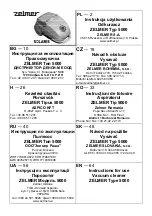
page 16 of 51
Documents are only to be used and distributed completely and unchanged. It is strictly the users´ responsibility to check carefully
the validity of this document with respect to his product. manual-no.: 999073 / 15/12/2009
During operation:
Do not start pump if
pressure difference
between inlet and outlet port exceeds
max.
1 bar
. Attempts to start pump at higher difference may cause blockade and damage of
the motor.
☞
Check compatibility with
max. permitted pressure
at outlet and
max. pressure
difference
between inlet and outlet ports.
Due to the high compression ratio of the pumps, pressure at the outlet port might be
generated being higher than the max. permitted pressure compatible with the
mechanical
stability
of the system.
The pump achieves its
pumping speed, ultimate total vacuum
and vapour pumping
rate only at operating temperature (after approx. 15 minutes).
☞
Prevent internal condensation, transfer of liquids or dust. The diaphragm and valves
will be damaged, if liquids are pumped in significant amounts.
☞
Let the pump run with
gas ballast
to reduce condensation of pumped substances
(water vapour, solvents, ....) in the pump.
In case of overload the motor is shut down by a
thermal cutout
in the winding.
☞
Manual reset is necessary. Switch off the pump or isolate the equipment from
mains. Wait approx. five minutes before restarting the pump. Identify cause of fail-
ure and eliminate.
☞
Use and operation of the controller see section
”Working with the controller”.
☞
Setting of interface parameters, see section
”Interface parameters”
.
☞
Preselections at the controller, see section
”Basic setups”.
Attention: Important notes regarding the use of gas ballast
☞
Make sure that air/gas inlet through the gas ballast valve never lead to hazardous,
explosive or otherwise dangerous mixtures. If in doubt, use inert gas.
☞
When using air rather than inert gas, risk of significant damage to equipment and/or
facilities, risk of personal injury or even loss of life exists due to the formation of
hazardous and/or explosive mixtures if air and pumped media react inside or at the
outlet of the pump.
For
condensable vapours
(water vapour, solvents, ...):
☞
Do not pump vapour before pump has reached its operating
temperature. Pump vapour with cas ballast open.
☞
Open gas ballast valve. (Closing of gas ballast valve by turn-
ing 180°.)
☞
With gas ballast valve open ultimate vacuum will be reduced,
pumping speed is decreased.
☞
Use inert gas at the air inlet to avoid the formation of explo-
sive mixtures.
In case of low boiling solvents when the formation of condensate is unlikely, the use of
gas ballast might be unnecessary.
☞
Operating the pump without gas ballast increases the solvent recovery rates at the
exhaust waste vapour condenser.
















































